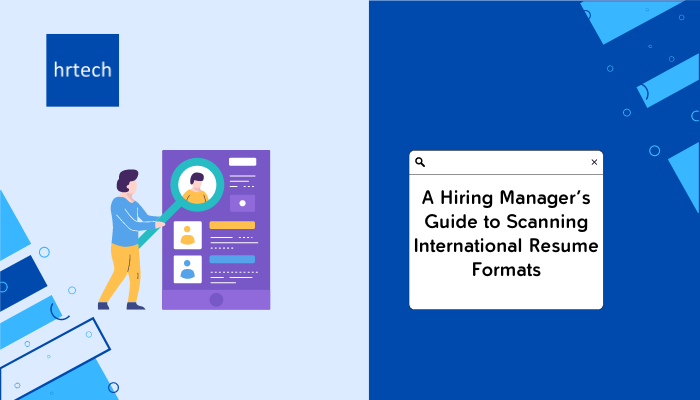Singapore regularly ranks as one of the best cities in the world to live and work. The city-state adopts an open, welcoming approach to talented professionals, while salaries average among the highest in the world. However, the international flavour of Singapore’s workforce can provide challenges for hiring managers. In this article, we discuss how to tackle the task of scanning international resume formats to make sure employers in Singapore have their pick of the strongest candidates, regardless of their nationality.
Why is it Important to Recognise Differences in International Resumes?
Recognising the differences between a Singapore resume and applications from the rest of the world can have a profound impact on your hiring practices. While applicants from other countries may do their best to replicate Singapore resume formats, it’s inevitable that you’ll find some differences in the structure and content of resumes from applicants across the world.
Being aware of the differences in international resume formats can help you with the process of vetting candidates. This starts with the ATS stage and continues through to the manual evaluation process. Knowledge of other countries’ CV customs and conventions can ensure you select the strongest candidates and reduce the likelihood of promising applicants slipping through the net.
What are the Differences of International Resume Formats?
The first thing to notice when it comes to international resumes is the differences by country in the use of ‘resume’ and ‘CV’. While the terms are used interchangeably in Singapore, this isn’t necessarily the case in every country. In the USA, for example, a resume is a short, one-page career summary. A CV, on the other hand, is a much longer, more comprehensive document suited to academic applications. This is the same for much of Canada.
The UK, Australia and New Zealand typically use the terms ‘CV’ and ‘resume’ interchangeably in the same way as Singapore. However, there may be differences between each country in the length and format of the document. The UK leans towards shorter resumes of between one and two pages, while in Australia and New Zealand, longer CVs of up to four pages are more common.
The content of resumes from the USA, Canada, UK, Australia and New Zealand are quite similar. Most follow a reverse-chronological format, prioritising work experience over education and skills. This is typically the format most suited to ATS software, so candidates from these countries are the least likely to encounter any issues.
You might find some slight differences in the resumes of European countries. Applicants from France, Germany and Belgium may include a personal photo in their CV, while employers in countries like France, Spain and Italy tend to request personal details such as date of birth, marital status and nationality. These details are far less common in resumes from English-speaking countries.
ATS Compatibility with International Resumes
When deploying ATS to support your recruitment efforts, it’s crucial to be aware of the potential compatibility issues that could disadvantage international applicants. Take a look at these key ATS considerations for international resumes:
Alternative resume layouts
While the reverse-chronological format is favoured in the UK and USA, you might see some different formats preferred by candidates from other countries. Applicants from some European countries might add their education before their work experience, offering a more comprehensive record of their qualifications. This can have implications for ATS systems and the customisations you make.
Differences in English spellings
While most applicants should submit their resume in English for jobs in Singapore, there can be differences in the type of English used throughout the world. This might affect compatibility with ATS software, with the spelling of certain words differing between, for example, US and UK English. Be aware of differences in job titles between countries so you can effectively scan resumes for candidates’ work history.
Differences in qualifications
Qualification names differ across the world, meaning that if the role you’re advertising has strict educational requirements, you might miss some candidates if they don’t translate their resume to use the local equivalents.
Short vs long form
Differences in the length of resumes between countries can also have an impact on the style of writing in the resume. Shorter resumes might pack in more keywords, while longer resumes may explain achievements, skills and experiences in a longer form.
Optimising ATS for International Resumes
The key to avoiding errors and oversights in your ATS recruitment processes is optimisation. Customising your ATS system can create a more bespoke, tailored experience and ensure you don’t miss out on credible international candidates. Take a look at these tips for optimising your ATS system for international resume formats:
Tailor your ATS for every role
Approach each vacancy individually and ensure your ATS has the right fields and functionalities to capture the best candidates, regardless of the country they’re applying from. Start by creating a bespoke plan for each vacancy and setting up your system to meet your requirements.
Be aware of international qualifications
Familiarise yourself with international qualifications. If you’re screening and ranking CVs according to educational achievements, make sure your system has all the necessary international equivalents of the key qualifications.
Be clear with job descriptions and keywords
Make sure your job description is as comprehensive as possible, to give candidates the best chance of making their application match the requirements. You might also consider adding instructions, such as to use UK English, or even the type and structure of resume you expect candidates to submit.
Use a wide range of keywords
Identify a wide range of carefully selected keywords to give you the best chance of including all valid and eligible international candidates. Think of international spellings, alternative words and job titles that could apply to relevant candidates from other countries.
Analyse and evaluate performance
As with any powerful data management application, ATS software provides in-depth insights and evaluation tools. Use these to track the performance of the system and conduct regular audits of vacancies to check whether you’re happy with the selection of candidates. If you identify errors with scanning international resumes, adapt the system and check back in the future to re-evaluate the process.
Key Takeaways for Effective Scanning of International Resumes
ATS systems have the potential to transform your recruitment practices. However, as with any system designed to create workflow efficiencies, they’re only as good as the inputs you feed them. As a recruiter in Singapore, it’s normal to receive applications from around the world, and your ATS system should be aligned to this. Mastering your ATS system can benefit your organisation and its ability to tap into overseas talent pools, helping you to gain an advantage in the Singapore job market.




